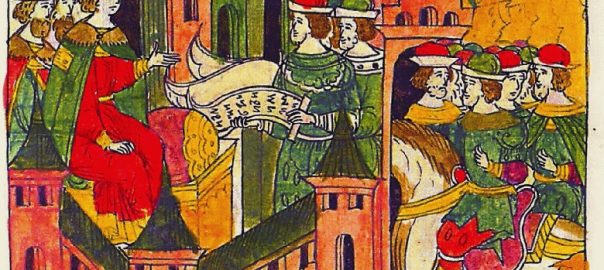In 1553 CE we’ll take a break from King/Emperor Charles of Spain and his bands of rapacious conquistadores (who continued their plundering and genociding, of course.) Attention turns to England and thence to some significant non-European empires. I suppose you might say the Ottoman Empire was at least partly European, though?
Anyway, here we go:
- In early July, King Edward VI, the 15-year-old who had succeeded his father Henry VIII to the throne just six years earlier, fell sick and died. Edward and his powerful regents had tried to have his cousin Lady Jane Grey named to succeed him, but a few days later the Lord Mayor of London proclaimed Henry’s elder daughter (of two) Mary I to be queen. Mary was then 37 years old and had a complex relationship with her dad. She had been raised (as we will recall) by her mother, Catherine of Aragon, as a devout Catholic and had often been shunned or carefully controlled by Henry. A few years before Henry died, though, he had invited Mary, her slightly younger (and Protestant) sister Elizabeth, and Edward over for a Christmas get-together; and in 1543-4 he and Parliament had designated an order of Succession that would run Edward > Mary > Elizabeth. (But presumably to go down to any heirs of Edward before reaching his sisters… had Edward grown old enough to have heirs, which he did not.)
- Upon Mary’s succession to the throne, she started arresting Anglican bishops and replacing them with Catholics. English-WP tells us, “In the month following her accession, Mary issued a proclamation that she would not compel any of her subjects to follow her religion, but by the end of September 1553, leading Protestant churchmen—including Cranmer, John Bradford, John Rogers, John Hooper, and Hugh Latimer—were imprisoned.[114] Mary’s first Parliament, which assembled in early October, declared her parents’ marriage valid and abolished Edward’s religious laws.[115] Church doctrine was restored to the form it had taken in the 1539 Six Articles of Henry VIII, which (among other things) reaffirmed clerical celibacy. Married priests were deprived of their benefices.”
- In 1553, the first stirrings of English colonial/trading ambitions outside of Europe were becoming evident. In August, explorer Richard Chancellor entered the White Sea, north of Russia, docking at Arkhangelsk, and taking a 600-mile sled trip to Moscow, to visit the court of Ivan IV of Russia (“the Terrible”), from whence he returned after some adventures to London. The image above is part of a contemporary Russian painting of Chancellor presenting his credentials to Ivan.
- Chancellor was representing a London-based body called the “Company of Merchant Adventurers to New Lands” that had been assembled by Edward VI shortly before his death and indeed was headed by his key regent, Lord Northumberland. Initially, its main goal was to “discover” a “Northeast Passage” to Cathay and the spice islands of the East Indies– in the same way the French guy Jacques Cartier had been searching for a “Northwest Passage” around the top of the Americas. The Southwest and Southeast passages from Europe to East Asia had been monopolized by Portugal (mainly) and Spain; but clearly there were French and English merchants very eager to get in on the action!
- By the way, this Company of Merchant Adventurers would later be known as the “Muscovy Company” and was a precursor for other similar British trading companies to come such as the Virginia Company, the Hudson’s Bay Company, the East India Company, and so on…
- In the Ottoman Empire, meanwhile, a somewhat ageing Suleiman the Magnificent fell for a ruse planned by his younger sons and arranged to have his oldest son (and presumed heir) the 38-year-old Şehzade (Prince) Mustafa executed. This caused some problems since Mustafa had been a very popular and successful army commander. But Suleiman was not yet losing his grip…
-

(Click to enlarge) In September, in northwest Africa, the Saadian dynasty, a Sufi-influenced crowd that had come out of the south of the country, consolidated their hold on an area comprising most of today’s Morocco (except the coastal enclaves held by the Portuguese and Spanish), and right down to Timbuctoo in today’s Mali/Niger. They would continue to have battles against the Ottomans, who were in today’s Algeria.
- In Ming Dynasty China, a new section of the Outer City fortifications in southern Beijing was completed, bringing the overall size of Beijing to 18 square miles (4662 hectares). And Shanghai was fortified for the first time. So despite the dissolute behavior of the emperor and continuing problems from naval pirates and terrestrial Mongols, the civil service still had some non-trivial capabilities.
